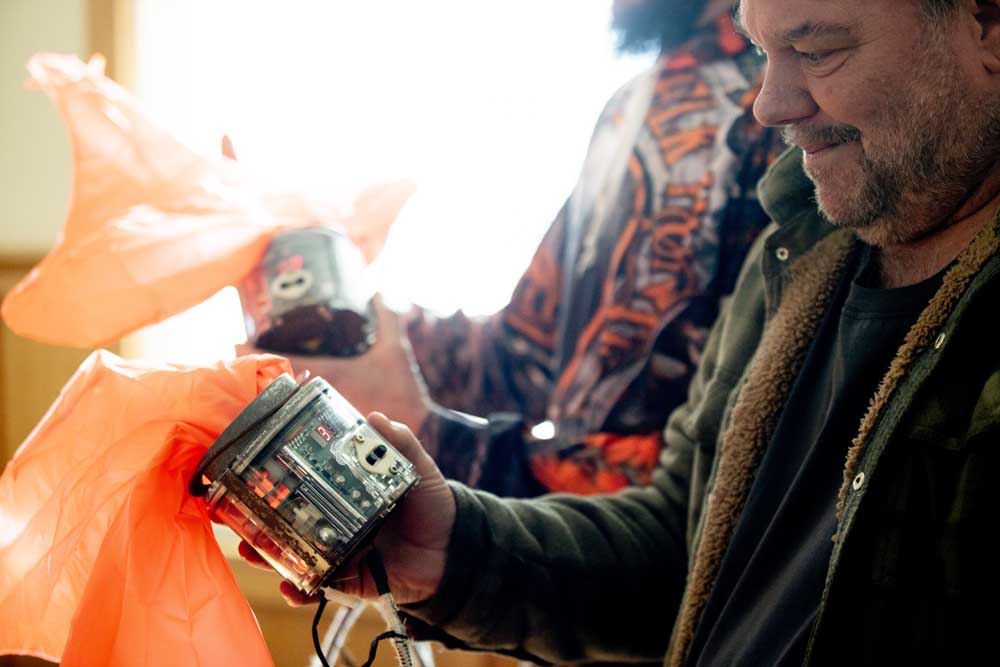Birding: Social interaction and interesting behavior right in your own backyard
Published 8:31 am Friday, January 29, 2021

- Robins are not the only birds who aren’t always keen to share the bird bath. The Audubon warbler taking a bath glares with open beak at another warbler that has decided to try to share the bath. Photo by Susan Stauffer
How closely should you watch the bird activity in your yard? Very closely is the watch word. Interesting behaviour is being played out right before our very eyes! Watching closely has shown me that birds are not just feeding. “They are coming and going and interacting with each other in a well-established social pecking order,” the Cornell Lab remarks. Juveniles, for example, generally have to wait their turn, while the adults dive in to satisfy their hunger first.
Trending
In my yard some male birds take precedence over females of the same species. The female downy woodpecker often comes to the suet only to be chased off by her male counterpart, but this behavior changes when a third downy tries to come to the suet. Then, the chase is really on! If the “intruder” is a female she is chased out of the yard by both the male and the female who were here first. Does this mean the chasers might be mates? If the intruder is another male, it can go either way. The intruder might have already or previously claimed the territory, so he is on the chase, but if the intruder is truly an intruder, he becomes the chased! This is just a guess on my part, but it seems like a plausible explanation.
I have two suet feeders in the yard. One on each side of the deck. One is a large rectangle that holds two suet cakes, while the other is cylindrical and holds the Wild Bird Store’s home-made suet cakes. Downies love both, but prefer the home-made suet as do the black-capped chickadees and red-breasted nuthatches. When the female downy or female nuthatch is feasting on the homemade insect laden suet and a male of either species shows up, the females vamoose or go to the other suet, which is usually full of nuts and peanut butter.
I find myself worrying if I don’t see the black-capped chickadee for a day or two. The solution I discovered, was to get up early to watch for bird activity. The other day I rose at the crack of dawn, opened the blind and there were two chickadees feeding to their heart’s content at the feeder of their choice. Then they were gone. The house sparrows came next followed by a few house finches. The red-breasted nuthatches were nowhere to be seen during the early part of the day. They finally showed up after the sparrows, finches and magpies retired from the yard for the night, and then the two black-capped chickadees returned. Research indicates that red-breasted nuthatches will completely dominate chickadees whenever they get the opportunity. This occurs at the feeder of homemade suet, but not at the seed feeders. There are many in the yard with a variety of seed, so the chickadees don’t have to tangle with the nuthatches and vice versa.
Trending
According to scientific research birds react differently to the presence of other birds, some become aggressive and feisty, some just fly away, and others will assume a posture that shows their dominance. Others will sit in a tree on the fence, or on an arbor and wait for a bird(s) to finish feeding or bathing. It seems that dominant birds usually win out when it comes to feeding or taking a bath. Large birds have it over smaller species. The American robin, for example, always dominates the bird bath in my yard. It bathes until it is good and ready to move. Other species who try to share are glared at with open beak until they back off. Whenever a raven or crow flies into the yard every bird, without exception scatters. Predators such as raptors have the same effect on the smaller yard birds. One exception that I noticed a year or so ago was the antics of a black-capped chickadee when a sharp-shinned hawk landed on a branch of the mountain ash tree so it could survey the bushes and undergrowth for a hidden treasure. In other words, its lunch! The black-capped chickadee had been feeding on black oil seed nearby for its lunch and wasn’t about to give way to this very large raptor that might have wanted it for lunch. It flew above and around its head “chick-a-dee dee deeing” all the while as if daring the Sharpie to take it down. It kept these antics up until the Sharpie became tired of the harassment and took off!
In spite of what seems like power struggles for a place at the feeders some birds get along famously. Every winter Bohemian waxwings come in to feed on the mountain ash berries. If there any left in the spring, the cedar waxwings come in to polish them off. The waxwings come in very large flocks. Sometimes there are as many as one hundred birds feasting side by side on the beautiful orange mountain ash berries. No arguments between them!
Watching bird behavior is an interesting and educational past time. Birding has so much more to offer than just a tally of what is being seen. Together these two activities along with photographing birds go hand in hand. For me, they brighten my day and fill it with joy. I hope you experience this too. Happy birding!









